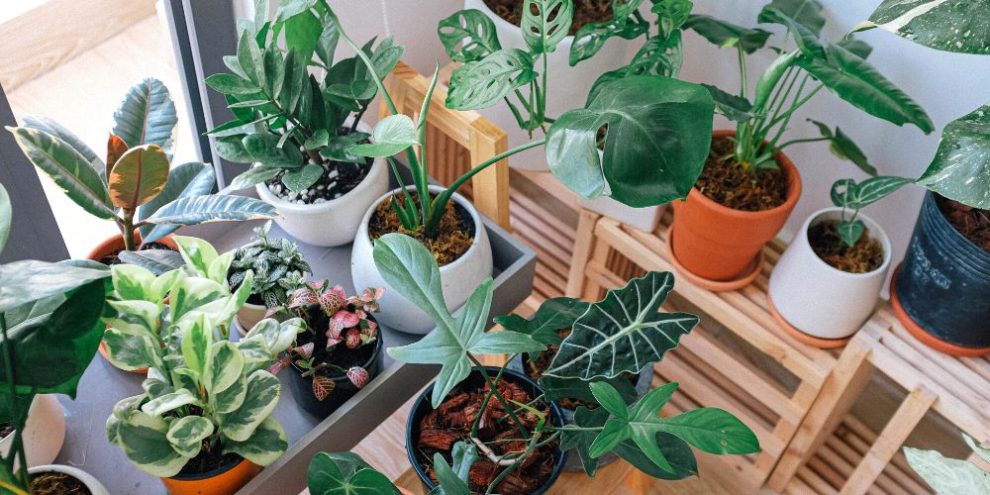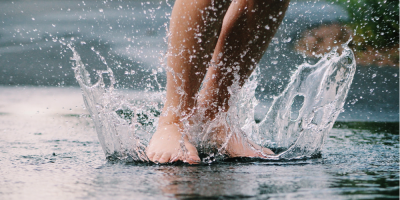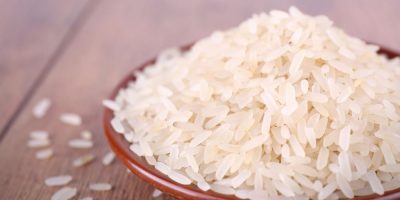
Houseplants are a great way to bring a bit of life and energy into your space, especially when the cold weather moves in. For those with green thumbs, owning indoor plants isn’t a problem. But for the rest of us, keeping plants alive can seem downright impossible.
Luckily, there are lots of low maintenance indoor plants that thrive on neglect, or at the very least minimal care.
Best Low Maintenance Indoor Plants
If you're looking for indoor plants that are low maintenance, give one of these a try:
1. ZZ Plant (Zamioculcas zamiifolia)
ZZ plants are incredibly popular among those with black thumbs. These modern looking plants from Africa can handle a wide range of lighting and are highly drought tolerant. This is thanks to their root system that stores water under the soil like a cactus.
Each ZZ plant can grow from 2 to 4 feet in height and width with multiple deep emerald green leaves on every stem. While they are great for naturally purifying the air, they can cause skin irritation and are not pet safe.
Sun: Low to bright, indirect
Soil: Well draining all purpose
Water: Water when soil is completely dry (around every 2 to 3 weeks)
2. Cast Iron Plant (Aspidistra elatior)
Cast iron plants are also incredibly hardy, low maintenance indoor plants. They’re resilient to temperature changes, insects and disease. And they’re drought tolerant.
As a member of the lily family, Cast iron plants grow stunning blooms near the surface of the soil. Though they’re most commonly kept for the glossy, deep green arching leaves. While they can handle little to no natural light, they do need lots of light to bloom.
Cast iron plants are also non toxic to pets, making them great for cat and dog owners.
Sun: Low, indirect to full shade
Soil: All purpose soil
Water: Water when soil is completely dry
3. Air Plant (Tillandsia)
Air plants have been getting a lot of attention lately. That’s because these otherworldly plants don’t need to be planted or kept in water. Instead, many people display these unique plants in glass globes or hanging vases. But anything can be used as a container. Some people even use shells, ceramic hands or wooden drawing mannequins.
Air plants come in many different varieties in several shapes and colours. Most vary from silver to green, though green plants tend to dry out faster. They also come in other colours like coral and red.
In general, these plants are non toxic to pets, though you should check each type of air plant you buy.
Sun: Bright, indirect
Soil: Epiphytic
Water: Submerge in water for around 30 minutes a week, dry them on a towel for a few hours and then put back in their holder
4. Begonia (Begoniaceae)
Looking to add some colour to your space? Then begonias may be a good option. There are over 1000 species of begonias plus hybrids. Some have colourful flowers, while others have eye-catching foliage in different tones and patterns.
Begonias aren't as low maintenance as other indoor plants on this list but they aren't too hard to care for.
When choosing your begonias, look for fibrous or cane begonias. These are the easiest to care for indoors. You can also grow rhizomatous begonias indoors. These have the showiest leaves with colours like yellow, pink, purple and more. But they are also harder to grow. Steer clear of tuberous begonias, as they don’t do well indoors.
In a dry home, especially in the winter, place your begonia pot in a shallow tray filled with water. This will help with humidity without water logging the plant.
Sun: Bright, indirect
Soil: Well-drained potting mix
Water: Water when soil is completely dry
5. Chinese Evergreen (Aglaonema)
Chinese evergreens are an excellent low-light indoor plant known for their lush decorative leaves. They are very easy to care for and come in several different colours, shapes and sizes. Green, red and white are the most popular colour mixtures, though you can find silver and pink variations as well.
Considered to be good luck, Chinese evergreens are great at cleaning toxins out of the air. However they do contain calcium oxalate, which are toxic to dogs and cats. That means they are best for pet free homes or in areas that your pets cannot get to.
These plants can be grown in soil or you can grow them in water for even less maintenance.
To grow in water, cut off a few 6” long stems and place them in water on a window sill. Once roots start to grow you can move them to soil, though they can stay in the glass.
Sun: Low to bright, indirect
Soil: Well-drained potting mix
Water: Barely moist at all times (under water instead of over watering to prevent root rot)
6. Spider Plant (Chlorophytum comosum)
There’s a reason almost every garden store has Spider plants. They thrive indoors and are nearly impossible to kill.
Spider plants have beautiful curved leaves that look great in a hanging planter or table pot. Some have all green leaves while others have a stripe down the centre which can add more interest. Moonshine snake plant is another great option - it has gray, blue green leaves
Smaller plants will begin to grow at the end of leaf stems - these can be cut off and planted in their own pots for more spider plants.
As an added bonus, they’re non-toxic for pets, though they can have a catnip-like effect on felines.
Sun: Bright, indirect
Soil: Well-drained potting mix
Water: Water when soil is completely dry
7. Pothos (Epipremnum aureum)
Pothos is another classic houseplant that you should be able to find in any garden store or centre. They’re fast growing, incredibly durable and can handle shady locations.
Their trailing vines add whimsy to any space and are great for hanging. The vines can also be directed upwards by using supports. Like spider plants, there are lots of different varieties. Golden pothos are the most popular with leaves that have hints of gold and varying shades of green.
Pothos are not safe for pets, so keep vines short. If you own a cat that loves to climb, you may want to steer clear of pothos altogether and opt for a pet safe plant.
Sun: Low to bright, indirect (avoid direct light s it will burn leaves)
Soil: Well-drained potting mix
Water: Water when soil begins to dry (about once every week or two)
8. Peace Lily (Spathiphyllum)
Peace lilies have deep waxy green leaves and feature beautiful spoon-like white blooms. While these plants do well in shadier spaces with artificial lights, you will need a natural light source if you want your peace lily to bloom.
Another great aspect of the peace lily is that it will let you know when it’s unhappy. If it isn’t getting enough water, the leaves will droop. Once you give more water, it will generally pop right back up.
Like other plants on this list, peace lilies are great at filtering toxins from the air.
Sun: Low, indirect
Soil: Well-drained potting mix
Water: Water once a week and mist with a spray bottle often
9. Snake Plant (Dansevieria zeylanica)
The snake plant, aka mother-in-law's tongue, is a succulent that’s known for its hardiness. Though they grow faster with more light, they can survive dark spaces and are great for filtering the air.
Homeowners light the snake plant as it’s very modern looking with long tapered leaves that grow upwards with very little arching. While there are other varieties, Dansevieria zeylanica has darker leaves than other snake plants. This is a nice change from the bright greens of most other low maintenance indoor plants.
Snake plants are not safe for pets to eat.
Sun: Low to bright, indirect
Soil: Well-draining cactus or succulent mix
Water: Water when soil is completely dry (about once per week)
10. Aloe Vera (Aloe barbadensis miller)
Chances are you’re familiar with aloe vera. That’s because its gel is often used in first aid to heal sunburns. But did you know you can grow your own aloe vera plant at home?
Aloe is a low maintenance succulent that is easy to grow at home. While there are many types of aloe plants, the most common is light green with white spots and slightly serrated with white spots.
Live plants can help clean toxins from the air and you can also use fresh gel from the leaves to heal burns, scrapes and other skin issues.
Aloe gel can also be safe for pets, however, it needs to be prepared properly or else it can be toxic. That means eating the plant from the pot will make cats, dogs and other pets very sick.
Sun: Bright, indirect
Soil: Cactus or succulent mix with good drainage
Water: Water when soil is completely dry
11. Bird’s Nest Fern (Asplenium nidus)
Bird's nest fern has bright wavy green leaves that add interest and lush forest or aquatic vibes to your space. While ferns are generally higher maintenance indoors, Bird’s nest fern is not. In nature, they actually grow on the surface of other plants. In nature they can grow fronds up to 5 ft long, but inside they generally grow to 2 ft max.
They’re also a great option for bathrooms as they like the humidity. Though you’ll want to be sure there’s a window for natural light.
Sun: Medium to bright, indirect
Soil: Well-drained potting soil
Water: Water one to two times a week, make sure soil is always slightly moist
12. Inch Plant (Tradescantia zebrina)
The inch plant is another trailing vine that’s hardy and fast growing, though it does take a bit more work. To encourage your inch plant to branch out, you’ll want to regularly remove a quarter of each tendril. To do this simply pinch of tender new growths with your finger and thumb. You can also use sharp pruning shears.
What makes it unique is striped leaves. While they can handle low light for short periods of time, they will quickly deteriorate. Instead, many people hang them in front of windows, as most species can handle the direct light.
Inch plants are also easy to regrow if yours does start to die. Simply cut off a healthy piece of the plant that is 3 to 4” long and place it in water. Once roots appear (about 2 weeks), plant the cutting in soil.
Sun: Bright, indirect (will tolerate lower light)
Soil: All purpose potting soil
Water: Water when soil is completely dry
13. Heartleaf Philodendron (Philodendron hederaceum)
Heartleaf philodendrons are similar to pothos but their leaves are heart shaped and grow in mounding cascades. They are also very easy to care for. Aside from the occasional watering, the only care that is needed is repotting if it outgrows its container and regular trimming of long stems. While even trimming isn’t really necessary, it will promote growth and keep the plant looking lush and healthy.
In nature, heartleaf philodendrons climb trees in tropical habitats. In your home, you can encourage them to climb columns or trellises with floral tape or soft plant ties.
Like inch plants, trims can be put into a vase and then planted once roots grow.
Sun: Low to bright, indirect
Soil: Well-drained potting mix
Water: Water when soil is completely dry
RELATED: Not sure what plant you're looking at? There's an app for that ...
14. Ponytail Palm (Beaucarnea recurvata)
The ponytail palm is not actually a palm or a tree, though visually it could be mistaken for one. In fact, the ponytail palm is really a succulent from the yucca family. That means it performs well in dry heated homes.
The ponytail palm is very dramatic and eye-catching with its thin arching leaves atop a thick stem. Generally they need bright indirect light but can handle low light up to 50% of the time.
Unlike many plants, ponytail palms also prefer being root bound. This means there’s no need to repot until the current pot cracks. When repotting, choose a container that is only an inch or two wider than the last.
Sun: Bright, indirect
Soil: Well-drained potting mix
Water: Water when soil is completely dry
15. Hoya Tricolour (Hoya Carnosa)
In the past, hoya tricolours were a staple of nearly every grandmother’s kitchen. Today, they are showcased in modern homes.
This tropical Asian plant is a trailing evergreen succulent that gives a jungle or rainforest aesthetic. What makes this plant especially unique is that a single leaf can have various shades of green, pink and cream. Sometimes, it even produces dainty flowers with a sweet fragrance.
While the hoya tricolour looks delicate, it’s incredibly hardy. That’s thanks to its drought resistance and long-living foliage.
Sun: Bright, indirect
Soil: Cactus or succulent mix with good drainage
Water: Water when soil is completely dry
If you’re looking for low maintenance indoor plants that are easy to take care of, consider giving one of these a try. While care varies from plant to plant, these are some of the easiest to maintain.
RELATED: How to maintain a year-round garden ...











